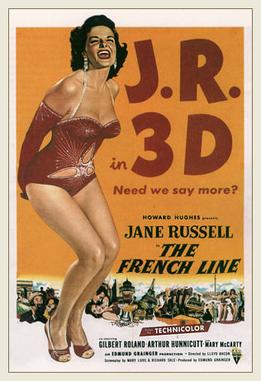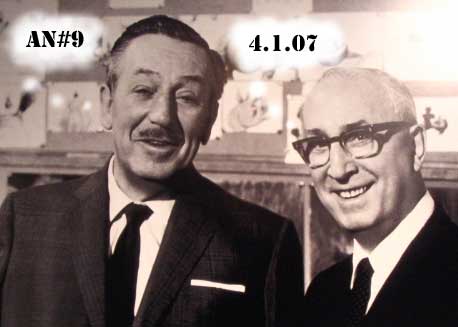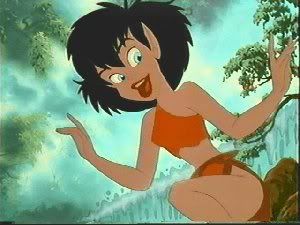And finally, the last segment of Christopher Finch's interview with Disney artist Al Dempster, discussing the now half-forgotten art of painting backgrounds with actual paint. (Find the first three parts here, here and here)...
CF: Some of the backgrounds I saw down in the Morgue were done in what appeared to be tempera.
AD: Yes.
CF: Was that used much?
AD: Tempera was used occasionally for short subjects. Years ago, we painted with transparent watercolor. Pinocchio was done with transparent watercolor. Just layer after layer after layer. And one of the artists, Art Riley, didn't like to work with it, so he decided to add a little bit of white to his transparent paint which gave it some body. He achieved some very interesting things with this method. About that time the Paint Lab ground some good poster color for our use.
CF: Why is it necessary to make all the colors here? Is it unavailable commercially?
AD: I think it's cheaper. I wonder if it is cheaper though, because actually, I don't think there is a better color made than that. [Referring to the designers color.] This is loaded with beautiful rich stuff. You take a green and you squirt some of it out and you take the richest green we have, and it looks chalky by comparison. That's why I have two different kinds here.
Frequently I have to resort to the designer colors if I want something rich and dark. If I want to change the tonality of something, and I want a transparent rich color, and get a beautiful tint that's bright and not white, then I’ll use the Liquitex [Acrilic] because it's an extremely brilliant, bright, clear color. You can put on just a small amount and still retain what you have. It is invaluable in warming or cooling an area without destroying the relationship of values. It's like holding a colored gelatin in front of the painting.
CF: What kind of surface do you work on?
AD: It's a very fine illustration board. And before it's shot, it's peeled off the board backing. The layouts are Xeroxed on the illustration board and also on the CL.
It is usual procedure before starting a painting to wet the illustration board on both sides. This removes most oil (from fingerprints) and allows the board to dry flat without a buckling. This wetting and consequent wetting many times before a background is complete causes the board to shrink.
As I had said, the illustration and a celluloïd (or CL) each are printed with a duplicate of the cleanup layout drawing. Because of this shrinking of the board the duplicate images would not register in some cases, and we had a problem until we called for pre-shrunk illustration board before the image was printed on it.
CF: Is there any Multiplane work on Robin Hood?
AD: Yes, they have to use the Multiplane camera to shoot these ten-field scenes. Outside of that, there's no Multiplane as such in the picture. The last time we used it was in Jungle Book and that was on some of the scenes in the forest. At the beginning and the end.
CF: When you were using the Multiplane more, was the background artist responsible for every level apart from the animation?
AD: I should say so. I had to start out this way: from a reduced drawing of all the levels involved in the scene I would make a sketch to determine how the assembled scene should look. When that looked possible, I would then proceed to first paint a large background then continue painting the level next to the background, then the next one away from the background and finally in this case [Al shows a Jungle Book background], these foreground trees were painted on the top or closest level. When the entire sandwich appeared, it would work. We would set up all the elements under the Multiplane camera, light each level, and from that dry run I would make whatever adjustments for color and value that were necessary.
CF: What are the levels painted on?
AD: They're painted on glass. In some cases they're painted on celluloïd then mounted on glass, but this is not very good because you can't put a platen down on that celluloïd when it's on glass to keep it flat. They're mostly always painted on glass. When there is animation it is usually on the bottom level on the background, then there is a platen which will hold it down.
CF: What kind of medium do you use to work on glass?
AD: We used to use oil, but now we find that we can prepare a surface that's going to be painted with black liquitex and then on top of that we can draw what is supposed to go on that and we can paint in either Shiva color, which is a casein color or we can use an acrylic. We can also use some of these, our regular colors, adding an acrylic medium if we want.
CF: Do you have any problem matching colors?
AD: On Multiplane we rarely have animation that will be a direct part of the material that you're painting in the background. Because it's very difficult to get animation on the level that the Multiplane painting will be on, because the animation has to be held down with the platen. That's why they try to put held areas that will go into animation later in the scene on the background level under the platen. Then in that case, if it's going to be part of the animation, like if a wall breaks down or something, that will always have to be on the part that would have a platen to hold things down, or else the cels would wrinkle and show up as highlights dancing accross the scene involved.
In Pooh, all those page turns were done on ten-field cels. This is difficult, because you know when you squash down two or three levels of cels, even though there is a great deal of pressure to the square inch, the darned things can get a little bubble of air and that shows up on the screen.
But I started out saying we paint the level with black liquitex or black acrylic on the glass, and the reason for that is each level is separately lit. Now when you get a glare from the light below a level, bouncing up, if it's a light value underneath upper level, it will reflect back in to the level down below. So they paint it black, then on top of the black, we paint the scene. It has to be painted black on the back so it isn't reflected on the level below. Many things that we found out were by trial and error.
CF: But there's no reason to use the Multiplane anymore? Is it a question of economy?
AD: Sometimes when there's a special need… I’m not saying that we won't use any for this picture, but I don't see any need yet. They used to go in for production shots, like in Pinocchio, where right out of the star comes the blue fairy down over the town. That took a long time to be painted. I remember Dick Anthony, who was one of the background men here: great guy. He did a great job making this scene.
We've had a lot of good painters. When I said the layout men did the drawing in full value, that didn't mean that all background people were neophytes. Because there were several who were darned good painters, or they never would have been able to do such fine work. But Dick Anthony painted this and he worked on it I guess maybe two months off and on. Painted it in oil. And some of the down shots, some of the street scenes took a long time to do.
That was probably the movie that used the most Multiplane. Now, there's less done with production things like that and less need for it, I suppose. There's more characterization, I think, in the last few pictures. Woolie likes to spend his time on the characters and the story part, rather than on the setting. He likes to get the setting over with, so he can get down to the business.
CF: How many regular 6 ½ field backgrounds are there in a feature?
AD: There are a little more than 900. Between 900 and a thousand.
CF: How long does each one take you to do?
AD: It varies considerably.
CF: Obviously, with the subject matter.
AD: You might go through and paint a dozen backgrounds and have them done in a week, or a week and a half or two weeks. And they look great, but then that's not quite what the director wanted. So we will make the necessary changes 'til he is satisfied. They are usually minor alterations.
CF: Do you often have to return to backgrounds that have already been done?
AD: Occasionally.
CF: Do you work strictly sequence by sequence?
AD: No. I jump all around. But I try to have a helper work in one area on a sequence whenever possible. Then it has a consistency within that area. And if there is a difference between that area and another one, we try to get a subtle transition between one set of backgrounds and another so you're not aware of any change. Even though everybody here who's painting for us is good, it's still not easy to get the darn things consistent in color and value because the semantics of painting is not always the same. No one sees things exactly as another person might.
CF: So how far are you into Robin Hood now?
AD: I don't know exactly how far. I had a list of how many backgrounds have been done: 400 or so.
CF: So about half way.
AD: Yes, maybe even a little bit more. But, as I say, we have only another year to go. Only!
CF: This is now very different from the old days where you… I mean the length of time you have and the number of people.
AD: True. We have a little longer now than normal because there are less people working on it. We have a smaller crew. It used to be that the features had as many as three directors on them. Like Gerry Geronimi and Ham Luske and Woolie: they were all on Sleeping Beauty. They each had three or four sequences. They would work more or less independently but check occasionally. When the sequences neared completion they would work out the tie-in of each sequence. Of course, they'd go back and forth and look at what each other was doing, to make sure there was a flow.
CF: And then you still had Walt as Director-in-Chief.
AD: Yes, and he knew what was going on. He did a lot of walking around at night. He had his finger in the pie. He was a smart old boy. A fantastic memory. Unbelievable. I was always flattered if he remembered my name, I really was. He had so many things on his mind and though I’d been here for quite a long time, not as long as many of us. I came here in 1939. Outside of the five years I had gone away…
I was working with books for the Studio and while I was gone, I’d have to come back occasionally to pick up work. I would be coming up the stairway and Walt and I would meet unexpectedly in the hallway, and of course I knew who he was, I didn't have any problem. But he didn't either. He called me by name and I darned near dropped over. How quickly the man could remember a name! I hadn't seen him for six months or a year, just enough to say hello, and he'd ask me how the apples were or something.
I had an apple and berry ranch up in Santa Cruz county. When I told him I wanted to get out of my contract and take my family on this ranch we had bought, he said, “I wish I could join you.” He talked about his days on his father's farm and how he used to ride the apple cart. He was a very human character. Real good guy. Real good guy. Too bad everybody has to go. But he made his mark, he really did.
CF: Were you ever involved in the story conferences on the early features?
AD: Rarely, once in a while. Not very often. Background work has always been considered as background work. I’ve always felt that backgrounding has not been given enough credit for its contribution to a picture. But if it weren’t for background painters, I mean good ones, there would not be good-looking pictures. Because we’re the ones that dish it all up for the camera.
It is not too difficult to talk a good background, but when you come down to it, it has to be painted. And if you know what the art schools are putting out today, you know how limited the approach would be. Extremely limited to mostly design and abstraction. They don't even teach life drawing or still life drawing or the basics. They don't teach the scales, as it were. All the kids entering art school want to become prima donnas, be Picasso right off the bat. They forget that he drew realistically and painted realistically before he does the stuff that he does, which I'd just as soon he’d forget. But he’s got a great promoter, I guess.
CF: Do you have young background artists?
AD: We’re scraping around, trying to find some young people. We’ve got a fairly young girl in there. We’ll have one starting in tomorrow. Very talented girls. Because we’re not going to be here forever. I’m not going to be. Unlike other places, we try to tell people everything we know, so we can help people fill our shoes.
We like to feel that we can get out of here and leave some of what we have found out behind us. You know, we don't have so many weekends left, and boy, there’s a lot of golf to play and a lot of paintings to paint. I do my own paintings, you know, which are not at all like this.
But we find art schools do not prepare students that we can use. We went to CalArts, we went to Art Center … I was amazed. I was an Art Center student from way back and they just don't have the type of qualifications necessary now. They're more for design, which is fine; there's a great need for it. But they're more for a commercial thing. For our specialized field, so few people have been taught the academic disciplines. It's the same way in animation. It's frantic time. I’ve been screaming for them to get people with talent to bring their samples in for ten years. I said you're not very far-sighted: we're not going to be here forever


































